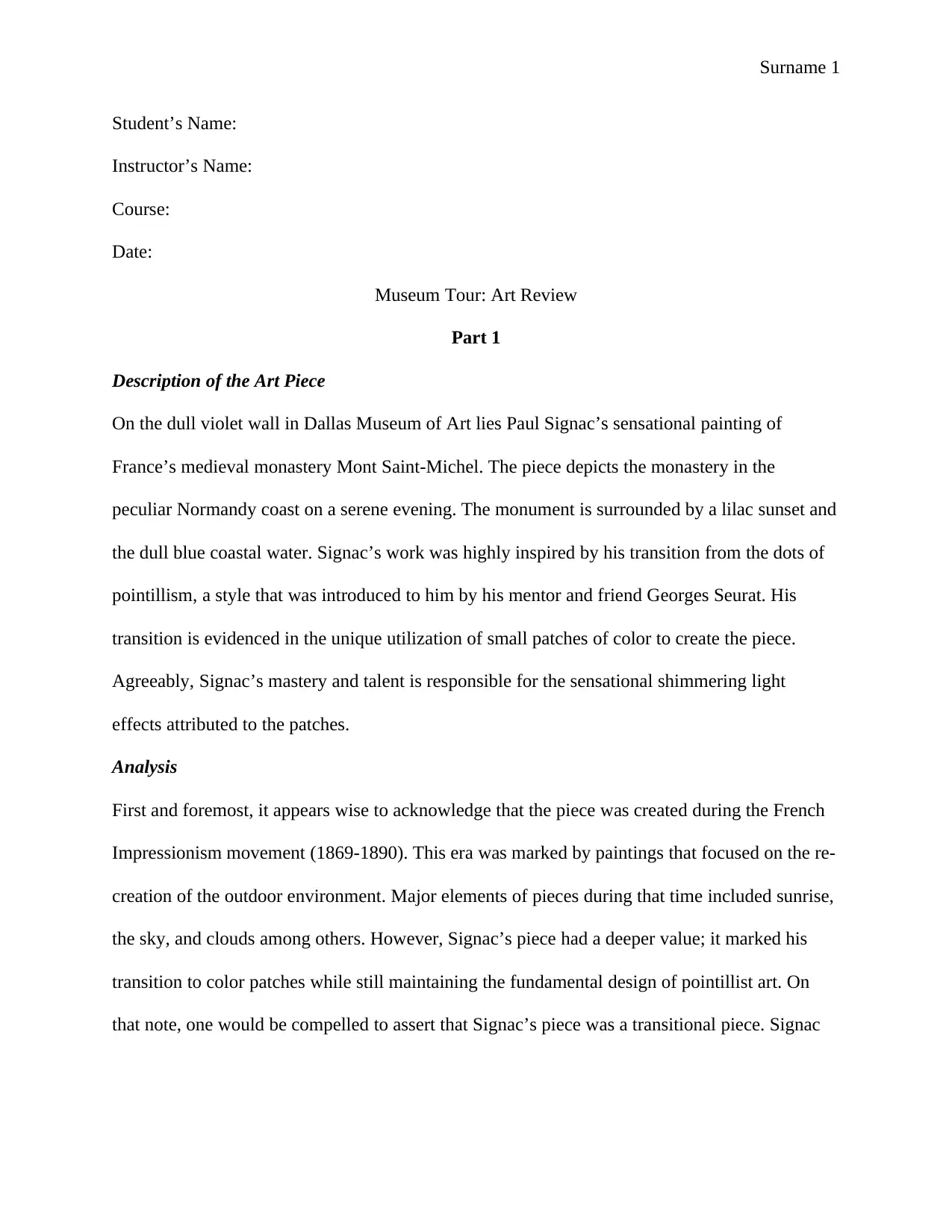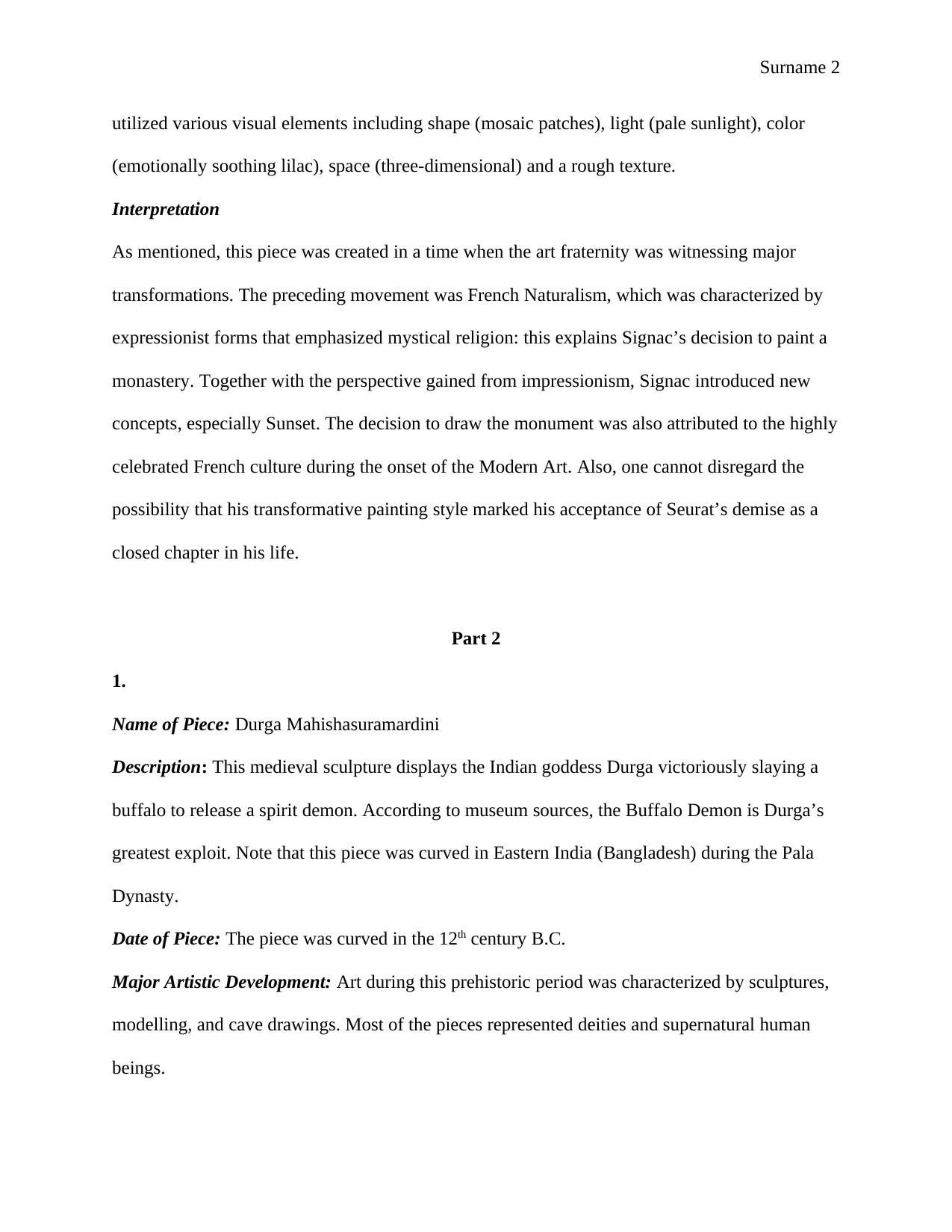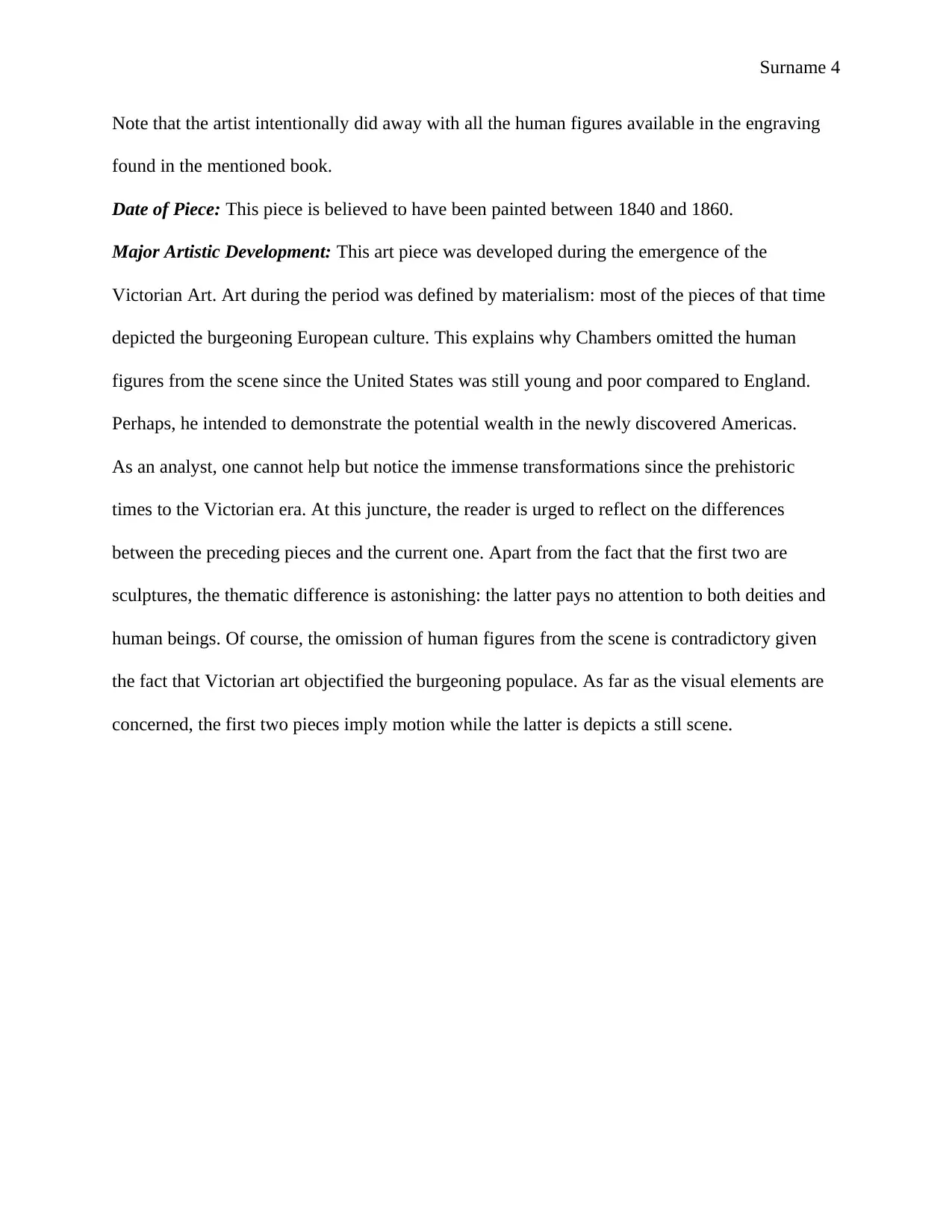Museum Tour: Art Review
VerifiedAdded on 2023/05/31
|5
|1061
|157
AI Summary
This text provides an art review of a museum tour, including descriptions, analysis, and interpretations of three art pieces. The pieces include a painting by Paul Signac, a sculpture of the Indian goddess Durga, and an oil on canvas piece by Thomas Chambers.
Contribute Materials
Your contribution can guide someone’s learning journey. Share your
documents today.

Surname 1
Student’s Name:
Instructor’s Name:
Course:
Date:
Museum Tour: Art Review
Part 1
Description of the Art Piece
On the dull violet wall in Dallas Museum of Art lies Paul Signac’s sensational painting of
France’s medieval monastery Mont Saint-Michel. The piece depicts the monastery in the
peculiar Normandy coast on a serene evening. The monument is surrounded by a lilac sunset and
the dull blue coastal water. Signac’s work was highly inspired by his transition from the dots of
pointillism, a style that was introduced to him by his mentor and friend Georges Seurat. His
transition is evidenced in the unique utilization of small patches of color to create the piece.
Agreeably, Signac’s mastery and talent is responsible for the sensational shimmering light
effects attributed to the patches.
Analysis
First and foremost, it appears wise to acknowledge that the piece was created during the French
Impressionism movement (1869-1890). This era was marked by paintings that focused on the re-
creation of the outdoor environment. Major elements of pieces during that time included sunrise,
the sky, and clouds among others. However, Signac’s piece had a deeper value; it marked his
transition to color patches while still maintaining the fundamental design of pointillist art. On
that note, one would be compelled to assert that Signac’s piece was a transitional piece. Signac
Student’s Name:
Instructor’s Name:
Course:
Date:
Museum Tour: Art Review
Part 1
Description of the Art Piece
On the dull violet wall in Dallas Museum of Art lies Paul Signac’s sensational painting of
France’s medieval monastery Mont Saint-Michel. The piece depicts the monastery in the
peculiar Normandy coast on a serene evening. The monument is surrounded by a lilac sunset and
the dull blue coastal water. Signac’s work was highly inspired by his transition from the dots of
pointillism, a style that was introduced to him by his mentor and friend Georges Seurat. His
transition is evidenced in the unique utilization of small patches of color to create the piece.
Agreeably, Signac’s mastery and talent is responsible for the sensational shimmering light
effects attributed to the patches.
Analysis
First and foremost, it appears wise to acknowledge that the piece was created during the French
Impressionism movement (1869-1890). This era was marked by paintings that focused on the re-
creation of the outdoor environment. Major elements of pieces during that time included sunrise,
the sky, and clouds among others. However, Signac’s piece had a deeper value; it marked his
transition to color patches while still maintaining the fundamental design of pointillist art. On
that note, one would be compelled to assert that Signac’s piece was a transitional piece. Signac
Secure Best Marks with AI Grader
Need help grading? Try our AI Grader for instant feedback on your assignments.

Surname 2
utilized various visual elements including shape (mosaic patches), light (pale sunlight), color
(emotionally soothing lilac), space (three-dimensional) and a rough texture.
Interpretation
As mentioned, this piece was created in a time when the art fraternity was witnessing major
transformations. The preceding movement was French Naturalism, which was characterized by
expressionist forms that emphasized mystical religion: this explains Signac’s decision to paint a
monastery. Together with the perspective gained from impressionism, Signac introduced new
concepts, especially Sunset. The decision to draw the monument was also attributed to the highly
celebrated French culture during the onset of the Modern Art. Also, one cannot disregard the
possibility that his transformative painting style marked his acceptance of Seurat’s demise as a
closed chapter in his life.
Part 2
1.
Name of Piece: Durga Mahishasuramardini
Description: This medieval sculpture displays the Indian goddess Durga victoriously slaying a
buffalo to release a spirit demon. According to museum sources, the Buffalo Demon is Durga’s
greatest exploit. Note that this piece was curved in Eastern India (Bangladesh) during the Pala
Dynasty.
Date of Piece: The piece was curved in the 12th century B.C.
Major Artistic Development: Art during this prehistoric period was characterized by sculptures,
modelling, and cave drawings. Most of the pieces represented deities and supernatural human
beings.
utilized various visual elements including shape (mosaic patches), light (pale sunlight), color
(emotionally soothing lilac), space (three-dimensional) and a rough texture.
Interpretation
As mentioned, this piece was created in a time when the art fraternity was witnessing major
transformations. The preceding movement was French Naturalism, which was characterized by
expressionist forms that emphasized mystical religion: this explains Signac’s decision to paint a
monastery. Together with the perspective gained from impressionism, Signac introduced new
concepts, especially Sunset. The decision to draw the monument was also attributed to the highly
celebrated French culture during the onset of the Modern Art. Also, one cannot disregard the
possibility that his transformative painting style marked his acceptance of Seurat’s demise as a
closed chapter in his life.
Part 2
1.
Name of Piece: Durga Mahishasuramardini
Description: This medieval sculpture displays the Indian goddess Durga victoriously slaying a
buffalo to release a spirit demon. According to museum sources, the Buffalo Demon is Durga’s
greatest exploit. Note that this piece was curved in Eastern India (Bangladesh) during the Pala
Dynasty.
Date of Piece: The piece was curved in the 12th century B.C.
Major Artistic Development: Art during this prehistoric period was characterized by sculptures,
modelling, and cave drawings. Most of the pieces represented deities and supernatural human
beings.

Surname 3
2.
Name of Piece: Dancing Figure
Description: This marble sculpture represents the divine entertainers in India during the
medieval times. The Dallas Museum of Art’s sources claim that the curving is highly likely to
result from a popular Indian religion known as Jainism. The religion was founded in the 6th
century B.C, and it was highly characterized by shapes of divine female dancers. Note that this
art piece was curved in Mount Abu, Rajasthan.
Date of Piece: The piece is believed to have been curved between the 12th and 13th century B.C:
amidst the descent of the Pala Dynasty.
Major Artistic Development: Like in the Durga Mahishasuramardini piece, this one was created
in a period where deities were emphasized in sculptures, cave drawings, and modelling.
However, one can note that there is a shift towards materialism in this piece.
When perceived from a critical point-of-view, one can note intense correlation between the
dancing culture depicted in the sculpture and the modern Hindu dance culture. The dancing
figure has been decorated by peculiar ornaments that remain vital in the modern Hindu dance
culture. Such resemblance has convinced me that art plays a colossal role in the creation and
maintenance of culture.
3.
Name of Piece: Eastport, and Passamaquoddy Bay,
Description: This oil on canvas piece was created by the England-born artist Thomas Chambers
to portray the Bay of Fundy: it includes Eastport, Passamaquoddy, and Maine. The aesthetic
piece is based on an inscription in Parker Willis’s 1840 nature guidebook American Scenery.
2.
Name of Piece: Dancing Figure
Description: This marble sculpture represents the divine entertainers in India during the
medieval times. The Dallas Museum of Art’s sources claim that the curving is highly likely to
result from a popular Indian religion known as Jainism. The religion was founded in the 6th
century B.C, and it was highly characterized by shapes of divine female dancers. Note that this
art piece was curved in Mount Abu, Rajasthan.
Date of Piece: The piece is believed to have been curved between the 12th and 13th century B.C:
amidst the descent of the Pala Dynasty.
Major Artistic Development: Like in the Durga Mahishasuramardini piece, this one was created
in a period where deities were emphasized in sculptures, cave drawings, and modelling.
However, one can note that there is a shift towards materialism in this piece.
When perceived from a critical point-of-view, one can note intense correlation between the
dancing culture depicted in the sculpture and the modern Hindu dance culture. The dancing
figure has been decorated by peculiar ornaments that remain vital in the modern Hindu dance
culture. Such resemblance has convinced me that art plays a colossal role in the creation and
maintenance of culture.
3.
Name of Piece: Eastport, and Passamaquoddy Bay,
Description: This oil on canvas piece was created by the England-born artist Thomas Chambers
to portray the Bay of Fundy: it includes Eastport, Passamaquoddy, and Maine. The aesthetic
piece is based on an inscription in Parker Willis’s 1840 nature guidebook American Scenery.

Surname 4
Note that the artist intentionally did away with all the human figures available in the engraving
found in the mentioned book.
Date of Piece: This piece is believed to have been painted between 1840 and 1860.
Major Artistic Development: This art piece was developed during the emergence of the
Victorian Art. Art during the period was defined by materialism: most of the pieces of that time
depicted the burgeoning European culture. This explains why Chambers omitted the human
figures from the scene since the United States was still young and poor compared to England.
Perhaps, he intended to demonstrate the potential wealth in the newly discovered Americas.
As an analyst, one cannot help but notice the immense transformations since the prehistoric
times to the Victorian era. At this juncture, the reader is urged to reflect on the differences
between the preceding pieces and the current one. Apart from the fact that the first two are
sculptures, the thematic difference is astonishing: the latter pays no attention to both deities and
human beings. Of course, the omission of human figures from the scene is contradictory given
the fact that Victorian art objectified the burgeoning populace. As far as the visual elements are
concerned, the first two pieces imply motion while the latter is depicts a still scene.
Note that the artist intentionally did away with all the human figures available in the engraving
found in the mentioned book.
Date of Piece: This piece is believed to have been painted between 1840 and 1860.
Major Artistic Development: This art piece was developed during the emergence of the
Victorian Art. Art during the period was defined by materialism: most of the pieces of that time
depicted the burgeoning European culture. This explains why Chambers omitted the human
figures from the scene since the United States was still young and poor compared to England.
Perhaps, he intended to demonstrate the potential wealth in the newly discovered Americas.
As an analyst, one cannot help but notice the immense transformations since the prehistoric
times to the Victorian era. At this juncture, the reader is urged to reflect on the differences
between the preceding pieces and the current one. Apart from the fact that the first two are
sculptures, the thematic difference is astonishing: the latter pays no attention to both deities and
human beings. Of course, the omission of human figures from the scene is contradictory given
the fact that Victorian art objectified the burgeoning populace. As far as the visual elements are
concerned, the first two pieces imply motion while the latter is depicts a still scene.
Secure Best Marks with AI Grader
Need help grading? Try our AI Grader for instant feedback on your assignments.

Surname 5
Reference
Dallas Museum of Arts. Dallas, Texas.
Reference
Dallas Museum of Arts. Dallas, Texas.
1 out of 5
Your All-in-One AI-Powered Toolkit for Academic Success.
+13062052269
info@desklib.com
Available 24*7 on WhatsApp / Email
![[object Object]](/_next/static/media/star-bottom.7253800d.svg)
Unlock your academic potential
© 2024 | Zucol Services PVT LTD | All rights reserved.